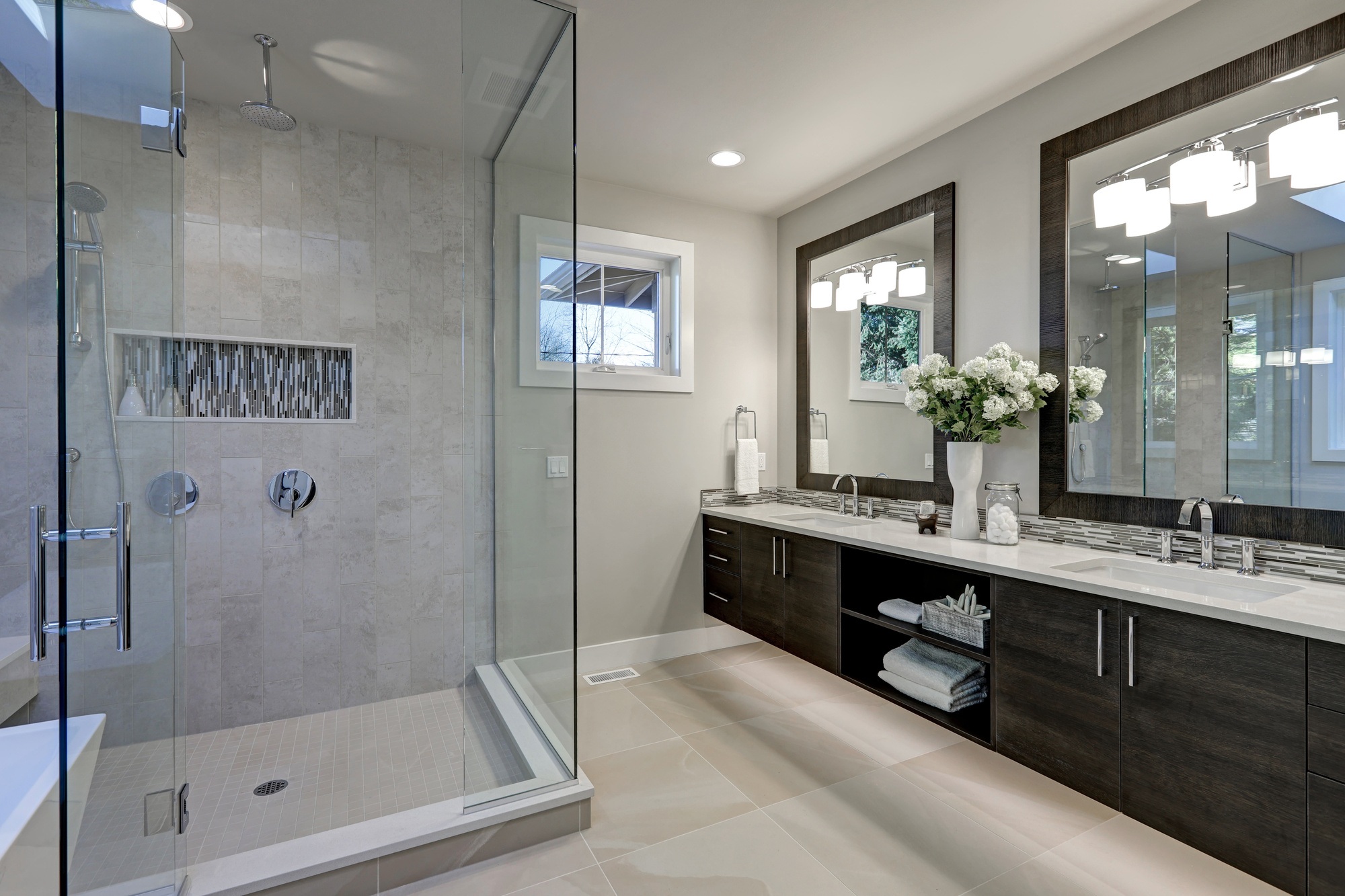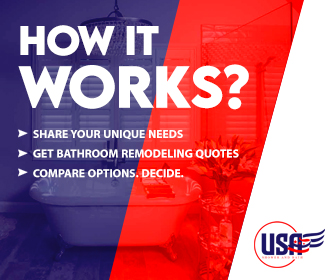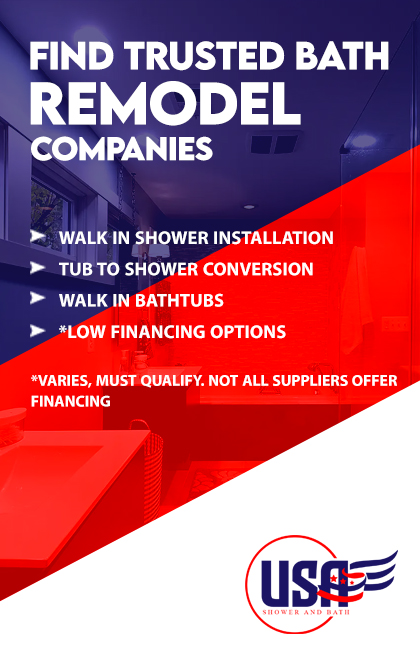
Ditching the Tub: Benefits of Converting Your Bathtub into a Shower
Over the years, bathroom designs have significantly evolved to match the lifestyle needs and preferences of homeowners. Among the noticeable shifts in modern bathroom layouts is the transition from bathtubs to showers. The reasons for this change are varied, but the common theme is the quest for functionality, aesthetics, and enhanced user experience. So, if you’re considering remodeling your bathroom and are stuck on the decision to retain or ditch your bathtub, this article is for you. Here are the compelling benefits of converting your bathtub into a shower and shower installation tips.
1. Space Optimization
Bathtubs, especially those that aren’t corner installations, can consume a considerable amount of floor space. If you’re working with a smaller bathroom, a shower can make the room feel more spacious. The open design of a shower, especially a frameless one, gives an illusion of more space, making the bathroom appear more expansive.
2. Enhanced Accessibility
One of the most significant advantages of a walk-in shower is its accessibility. This is especially beneficial for elderly individuals or those with mobility issues. Without the need to step over a high tub edge, the risk of slips and falls is reduced. Many modern showers also come equipped with grab bars and non-slip floors for added safety.
3. Modern Aesthetics
A well-designed shower can significantly uplift the aesthetic appeal of your bathroom. With a wide range of design options available, from tiles to fixtures, showers can be tailored to reflect contemporary design trends. Frameless glass doors, rainfall showerheads, or even the incorporation of a bench or niche, can elevate the visual appeal of your bathroom.
4. Water and Energy Efficiency
Showers, especially those with modern fixtures, often use less water than bathtubs. This means potential savings on water bills over time. Furthermore, with the reduction in water usage, there’s also less demand on water heaters, translating to energy savings.

5. Easy Maintenance
Shower stalls, especially those without intricate designs and grouting, are often easier to clean than bathtubs. The absence of hard-to-reach corners and edges ensures that maintaining hygiene is simpler. Additionally, modern showers are designed with materials that resist mold and mildew growth.
6. Increased Resale Value
An updated bathroom, especially one that caters to the latest trends and the needs of a broader range of potential buyers, can increase the resale value of your home. Many homebuyers today prioritize modern, accessible, and efficient bathrooms.
7. Customization Opportunities
One of the exciting aspects of transitioning to a shower is the wide array of customization options available. From multi-jet shower panels to the incorporation of smart technology that allows for temperature and water flow control, the choices are vast.
8. Environmental Considerations
Given that showers generally use less water, especially when equipped with low-flow showerheads, they’re a more environmentally friendly option compared to bathtubs.
Converting your bathtub into a shower can be a transformative experience for your bathroom. Not only does it cater to the functional needs of most modern families, but it also offers a host of other benefits ranging from aesthetics to efficiency. Before making the transition, it’s essential to consult with professionals to ensure a smooth and successful conversion process.

How to Convert Your Tub to a Shower
Converting a bathtub to a shower is not just a simple swap-out scenario. It involves several steps, which, when done meticulously, can ensure you have a seamless and efficient shower space.
- Assessment: Before initiating the conversion, assess the current plumbing, drainage, and space. This will give you a clear idea of the kind of modifications required.
- Demolition: This step involves safely removing the existing bathtub. It’s crucial to ensure that there’s no damage to the existing plumbing or surrounding areas.
- Flooring and Drainage: With the tub removed, the next step is to prepare the floor. This might involve leveling and ensuring proper drainage. Typically, showers require a slightly sloped floor for efficient water flow towards the drain.
- Waterproofing: This is crucial to prevent any potential water damage to the floors or walls. Waterproofing ensures that water from the shower remains contained and doesn’t seep into other parts of the home.
- Wall Preparation: Depending on the design you’ve chosen, this could involve adding tiles, acrylic, or other wall coverings that are suitable for wet areas.
- Installation: Once everything is set, it’s time to install the shower base, walls, and any other fixtures you’ve chosen.
- Final Touches: This includes sealing, adding shower screens or curtains, and installing other accessories like shelves or grab bars.
Hiring a Professional for Tub to Shower Conversions
While there are DIY kits available for those who are confident in their home improvement skills, many people opt to hire professionals to ensure the conversion is done right. Here’s why:
- Expertise: Professionals have the necessary training and experience to handle unforeseen issues, such as hidden water damage or outdated plumbing.
- Time-saving: A professional team can complete the conversion faster than an amateur DIYer, allowing you to use your new shower sooner.
- Warranty and Guarantees: Many professional services offer warranties on their work, ensuring peace of mind.
- Equipment and Tools: Professionals have access to specialized tools and materials that might not be readily available to the average homeowner.
- End-to-end service: From design consultation to clean-up post-installation, a professional service often handles all aspects of the conversion.
When considering the conversion from a bathtub to a shower, it’s crucial to weigh the benefits against the costs and potential challenges. By being informed and considering both the DIY and professional routes, you can make the best decision for your home and lifestyle.

How Much Does It Cost to Convert a Bathtub to a Shower?
When contemplating a bathtub to shower conversion, one of the primary concerns for homeowners is the cost. Understanding the factors that influence the expense can help in budgeting and decision-making. The conversion cost can vary widely depending on several factors, ranging from the region you’re in, the complexity of the project, the materials selected, and whether you choose a DIY approach or hire professionals. Here’s a detailed breakdown:
1. Labor Costs: Professional labor typically makes up a significant portion of the total project cost. On average, labor costs can range from $1,000 to $3,000, depending on the complexity and duration of the job. This price can go up if any complications arise, like plumbing issues or structural modifications.
2. Shower Stall & Fixtures: The type of shower you choose plays a significant role in the cost. Prefabricated shower stalls can range from $200 to $2,000. Custom tiled showers, on the other hand, can range from $1,000 to $5,000, based on the choice of tiles and design complexity.
3. Plumbing Adjustments: If your new shower design requires moving the existing plumbing or installing new fixtures, there will be additional charges. Plumbing modifications can add anywhere from $300 to $3,000 to the total cost. High-end fixtures, like rain showerheads or multiple jet systems, will be on the pricier side.
4. Flooring & Drainage: The floor of your new shower may need some adjustments to accommodate drainage. Whether you choose a simple shower pan or opt for a custom-tiled base, this can add $100 to $1,000 to your project.
5. Waterproofing: Ensuring your shower is properly waterproofed is essential. Waterproofing materials and labor can add an additional $500 to $1,000 to the cost.
6. Wall Materials: The choice of wall material is another factor. Acrylic or fiberglass surrounds can be on the lower end, costing between $100 to $500. In contrast, ceramic, porcelain, or stone tiles can range from $500 to $3,000 or more, depending on the choice and coverage area.
7. Additional Features: Additional features, such as built-in niches, benches, or advanced shower systems, can also influence the cost. These can add an extra $100 to $2,000, depending on the selections.
8. Miscellaneous Costs: Other potential costs to consider include permits, waste disposal, or any required structural modifications.
Total Estimated Cost: Considering all these factors, converting a bathtub to a shower can range from as low as $3,000 for a simple project using prefabricated materials to over $10,000 for a high-end custom renovation.
It’s crucial to note that these are average estimated figures, and actual costs can vary based on individual project specifics, regional pricing variations, and individual contractor rates. Always obtain multiple quotes and ensure that all aspects of the job are detailed in the contract to avoid unforeseen expenses.

What is the Best Material for a Tub to Shower Conversion?
When converting a bathtub to a shower, choosing the right material is crucial. The material you select should not only align with your aesthetic preferences but also be durable, easy to maintain, and suitable for the bathroom’s moisture-rich environment. Here’s a guide to some of the most popular materials used for tub-to-shower conversions:
Acrylic:
- Pros: Acrylic is a popular choice due to its durability and affordability. It’s resistant to scratching, fading, and chipping. Acrylic showers are also easy to clean, with a non-porous surface that resists mold and mildew.
- Cons: If not installed properly, they can flex or feel less sturdy underfoot.
Fiberglass:
- Pros: Fiberglass is another affordable option. It’s lightweight and comes in a variety of shapes and sizes.
- Cons: Over time, fiberglass can fade and scratch more easily than some other materials. It’s also more susceptible to cracking under heavy impact.
Ceramic and Porcelain Tiles:
- Pros: Tiles offer a lot of customization in terms of design, color, and pattern. They are durable and can withstand moisture well. Porcelain tiles, in particular, are denser and less porous than ceramic tiles, making them even more water-resistant.
- Cons: Grout lines between tiles can become a hotspot for mold and mildew if not sealed and cleaned regularly. Tile surfaces can also be slippery unless you opt for textured varieties.
Natural Stone Tiles (e.g., marble, granite, slate):
- Pros: Natural stone offers a luxurious and unique look, with each tile having its distinct pattern. It’s durable and long-lasting.
- Cons: Natural stone can be expensive and requires regular sealing to maintain its look and prevent water absorption. It can also be slippery when wet.
Cultured Marble:
- Pros: Cultured marble is a mix of marble dust and resins. It offers a seamless look, eliminating grout lines. It’s also resistant to chipping, staining, and is easy to clean.
- Cons: It might not have the same luxury feel as real marble and can discolor over time if not maintained properly.
Solid Surface:
- Pros: Materials like Corian create a seamless and modern look. They can mimic the appearance of natural stone without the maintenance challenges. They’re durable and can resist stains and mildew.
- Cons: They can be more expensive than acrylic or fiberglass options.
Tempered Glass (for doors or enclosures):
- Pros: Tempered glass doors or enclosures give a spacious feel to the bathroom. They are sturdy and can resist impacts.
- Cons: They require regular cleaning to prevent water spots and streaks.
The best material for your tub to shower conversion largely depends on your budget, design preferences, and how much maintenance you’re willing to commit to. It’s always a good idea to discuss with a bathroom remodeling expert who can provide insights tailored to your specific needs and bathroom conditions.

Key Features to Consider During Your Tub to Shower Conversion
Transitioning from a bathtub to a shower is more than just a matter of removing the tub and installing a shower pan. It’s an opportunity to enhance the functionality, safety, and aesthetics of your bathroom space. As you embark on this renovation journey, here are some key features to mull over:
1. Shower Base Type:
There are several options available, from prefabricated acrylic or fiberglass bases to custom-tiled bases. Your choice will affect both the aesthetics and cost of the project.
2. Shower Doors vs. Curtains:
While shower curtains are versatile and cost-effective, sliding or hinged glass doors can add a touch of luxury and modernity. Frameless glass doors, in particular, can make the bathroom feel more spacious and are easier to clean.
3. Showerheads and Fixtures:
From standard wall-mounted showerheads to rain showers, handheld sprayers, and body jets, there’s a wide range to choose from. Consider the kind of shower experience you desire and your budget.
4. Built-in Storage:
Niches or recessed shelves can be integrated into the shower walls to store shampoos, soaps, and other essentials. Corner shelves or even built-in benches can also be considered.
5. Safety Features:
Non-slip flooring materials, grab bars, and handheld showerheads can make the shower safer for everyone, especially seniors or individuals with mobility challenges.
6. Waterproofing:
Ensure your contractor uses proper waterproofing measures like backer boards, membranes, and specialized seals to prevent any future water damage or mold growth.
7. Ventilation:
If your bathroom doesn’t already have adequate ventilation, it might be wise to consider adding or upgrading an exhaust fan. Proper ventilation reduces humidity, curbing mold and mildew growth and maintaining the integrity of your fixtures.
8. Lighting:
While natural light is always a great option if possible, you might also think about installing dedicated shower lighting. Recessed LED lights or even a lighted showerhead can enhance the ambiance.
9. Wall Materials:
While tiles are the most common choice due to their water-resistant nature, there’s a vast range to choose from—ceramic, porcelain, glass, natural stone, and more. Alternatively, acrylic or fiberglass wall panels offer a seamless look that’s easy to clean.
10. Eco-friendly Features:
Consider fixtures that help in water conservation, such as low-flow showerheads or systems that reuse water. This not only saves on your water bill but also contributes to a sustainable environment.
When planning a tub to shower conversion, the emphasis should be on balancing functionality with design. It’s an investment that not only adds to your daily comfort but can also increase the overall value of your home. Always remember to consult with professionals and get multiple quotes to ensure you’re getting the best quality for your budget.

Common Mistakes to Avoid During Tub to Shower Conversion
Embarking on a tub to shower conversion is exciting, but like all renovation projects, there’s room for error. Being informed about potential pitfalls can save you time, money, and future regrets. Let’s discuss some of the common mistakes to avoid during this process:
1. Overlooking Drain Placement:
Many bathtubs have their drain at one end, while many shower stalls place the drain in the center. Failing to account for this can lead to added costs and complicated plumbing adjustments.
2. Ignoring Local Building Codes:
Every locality has its building codes and regulations. Skipping a check on these can result in renovations that don’t meet standards, potentially affecting insurance claims or the resale value of your home.
3. Skimping on Space:
A comfortable shower space is essential. Ensure that you allocate enough space for movement, especially if you’re considering adding benches or other features.
4. Not Thinking Long-Term:
Design trends come and go. While it’s tempting to go with the latest design fad, consider how the look and functionality will age over time. Neutral designs and quality materials generally have better longevity.
5. Overlooking Future Needs:
As you age or if your physical circumstances change, your needs in a shower space might evolve. Think about incorporating features like grab bars or a no-threshold design from the start, rather than having to retrofit later.
6. Failing to Address Underlying Issues:
Before installing your new shower, thoroughly inspect for any signs of mold, rot, or structural issues. Addressing these problems upfront can prevent costly repairs down the line.
7. Poor Quality Fixtures:
While it might be tempting to save money on fixtures, investing in high-quality items can pay off in the long run. Quality fixtures often last longer, work better, and come with better warranties.
8. Neglecting Ventilation:
Even if you addressed ventilation during your design phase, ensure that it remains effective after the conversion. Proper ventilation is essential for preventing mold and maintaining air quality.
9. Inadequate Waterproofing:
The shower area is constantly exposed to water. Any compromise in waterproofing can lead to significant issues like mold growth or structural damage.
10. DIY without Experience:
While many homeowners are embracing the DIY trend, certain aspects of a tub to shower conversion, like plumbing and waterproofing, can be complex. If you’re unsure about any step, consider hiring a professional to ensure the job is done right.
Converting a tub to a shower can be a rewarding endeavor, adding both value and comfort to your home. However, it’s essential to approach the project with thorough planning and awareness of potential pitfalls. By doing so, you can enjoy a seamless conversion process and a shower space that serves you well for years to come.

Tips for Maintaining Your New Shower Space
Once you’ve successfully converted your bathtub to a shower, it’s essential to know how to maintain it to ensure longevity, cleanliness, and maximum functionality. Here are some tips to help you keep your shower space in top shape:
Regular Cleaning:
- Use a squeegee or a microfiber cloth to wipe down the shower walls and doors after each use. This helps in preventing soap scum build-up and reduces the growth of mold and mildew.
- Avoid abrasive cleaners which can scratch or dull the surfaces. Instead, opt for mild detergents or natural cleaning solutions like a mixture of white vinegar and water.
Check for Leaks:
- Periodically inspect the caulking and seals around the shower, especially near the floor and corners. Address any signs of wear or leaks promptly to avoid water damage or mold growth.
Ensure Proper Ventilation:
- Always turn on the exhaust fan during and after taking a shower to reduce moisture accumulation. If you don’t have a fan, consider installing one or make sure to leave the bathroom door or window open for a while after showering.
Update Shower Fixtures:
- Over time, fixtures can wear out or become outdated. Keeping them updated not only ensures functionality but can also refresh the look of your shower space.
Address Grout Issues:
- If you have tiles in your shower, it’s crucial to monitor the condition of the grout. Clean it regularly and reseal it if necessary to prevent water seepage and mold growth.

Use Quality Products:
- Investing in quality shower products can help in the longevity of your fixtures and surfaces. For instance, using a mild, pH-balanced shower gel instead of bar soap can reduce soap scum buildup.
Avoid Harsh Chemicals:
- Drain unclogging chemicals can be abrasive and potentially damage your pipes or shower floor. Instead, use natural alternatives or a plunger to address minor clogs.
Add Protective Mats:
- Consider adding a non-slip mat inside the shower and a water-absorbent one outside. This ensures safety and also keeps the bathroom floor dry.
Regular Inspections:
- Every few months, take the time to inspect your shower thoroughly. Check for signs of damage, leaks, or wear and tear. Addressing small issues promptly can save significant repair costs in the future.
While converting a bathtub to a shower offers many advantages and modernizes your bathroom space, it’s equally crucial to ensure its proper care. By adopting a regular maintenance routine and addressing issues promptly, you can ensure your shower remains a functional and aesthetic asset in your home for many years.
